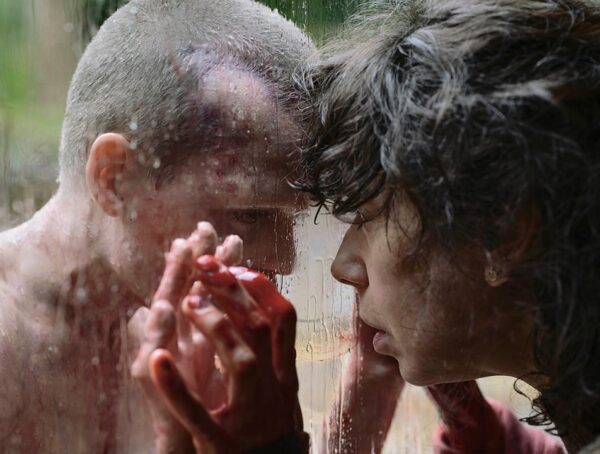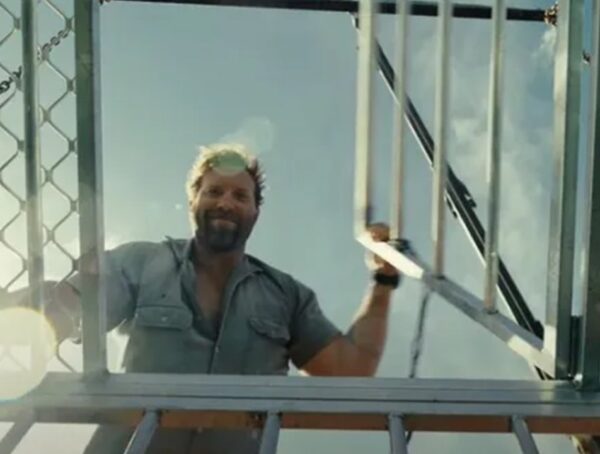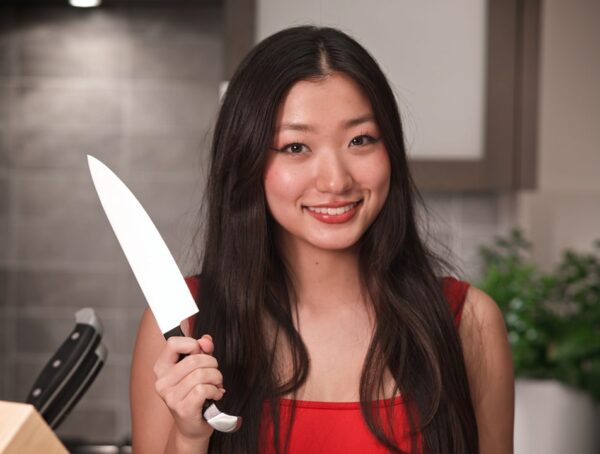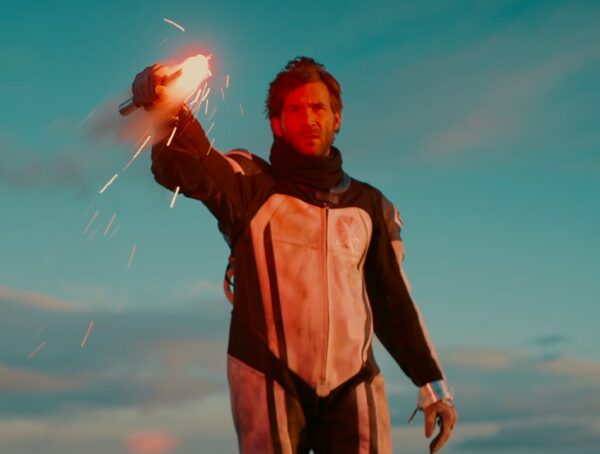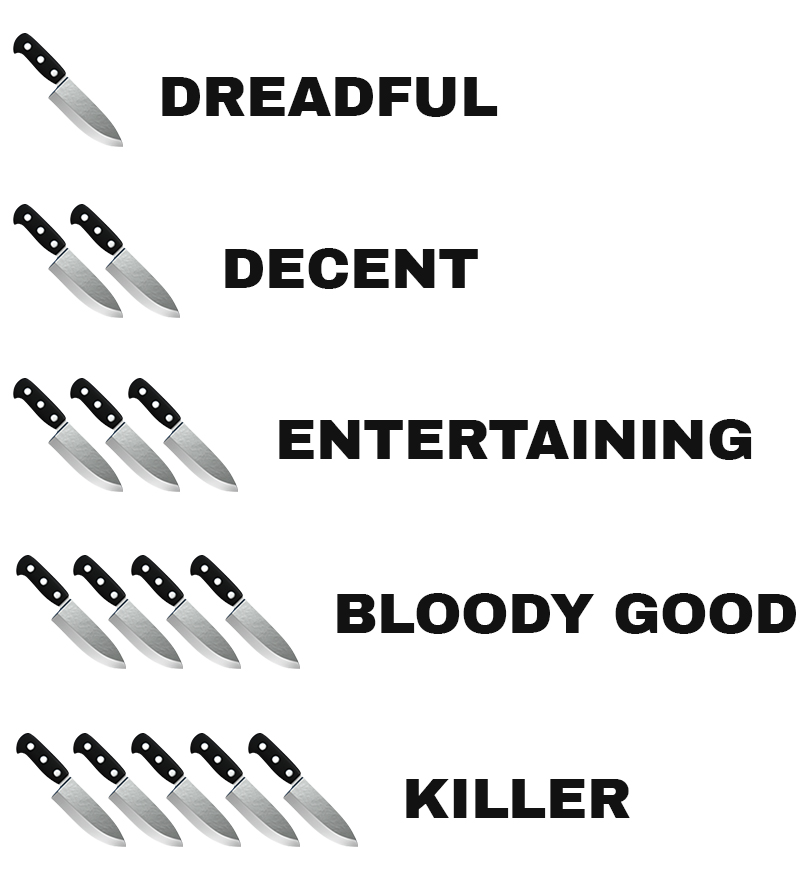Sponsored Feature: Headcheese Films, OddDog Pictures
Shadows of Willow Cabin, written and directed by Joe Fria, masterfully merges queer romance with supernatural horror, crafting a moody, intimate, and chilling cinematic experience that unfolds like a dark fever dream.
Watch the trailer here:
Albert and Devon retreat to a remote cabin to explore a connection sparked by a string of sexually charged messages on a dating app. Albert is a closeted husband struggling with the collapse of his heterosexual identity; Devon is a wounded soul who uses fleeting affairs with married men to shield himself from his past. As their bond deepens, reality begins to fracture. The forest won’t let them leave. The walls whisper with voices they’ve tried to forget. And the cabin itself seems alive, bending time and conjuring personal ghosts in physical form. Trapped in a metaphysical bubble, the men must confront the truths they’ve spent their lives avoiding… before the cabin consumes them both.
A Q&A with writer/director Joe Fria
Welcome, Joe! Thanks for joining us to discuss your new queer romantic horror film, Shadows of Willow Cabin. What drew you to this story, and how did you become interested in exploring themes of identity, trauma, and queer romance in a horror context?
I set out to write a micro-budget horror film with very specific parameters to keep it affordable. At first, it was about a gay couple haunted by a homophobic ghost. But as I was writing, it felt too easy. Like I was skimming the surface of something deeper. It wasn’t landing emotionally. So I forced myself to dig into what actually scared me. Not just externally, but internally. I started pulling from my own experiences. Things I hadn’t fully processed yet. And that was terrifying in a completely different way. But once I did that, the story cracked open. So much of Shadows of Willow Cabin comes from that place. I was thinking about how queer people carry trauma, and how we learn to navigate intimacy through a lens of caution. Even love can start to feel like something to defend yourself against. That idea really stuck with me: how connection and fear can live side by side. This story grew out of that tension. The characters reflect different versions of that. One is holding on to an identity that’s quietly collapsing. The other has made a home in detachment, only reaching for people who can’t reach back. I’ve known those patterns. I’ve lived them. And I wanted to see what would happen if two people like that were forced to sit still, together, with no distractions. Just the quiet. Just the truth. Horror has always been the most honest genre to me. It lets you explore the things we try to ignore. It turns the emotional into something physical. The cabin, the looping time, the sense that something is watching, it’s all just a reflection of what these characters haven’t faced yet. And what I hadn’t faced either, until I wrote it.
So I forced myself to dig into what actually scared me. Not just externally, but internally. I started pulling from my own experiences. Things I hadn’t fully processed yet. And that was terrifying in a completely different way.
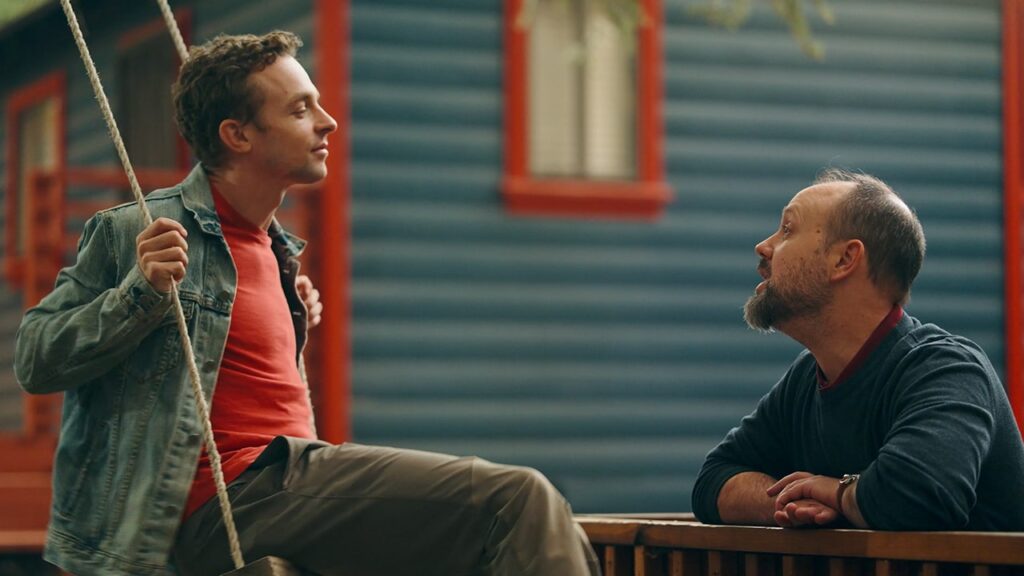
Were there any specific horror or queer cinema influences that you drew upon during the filmmaking process?
Most of the stories that shaped me early on were horror films. Movies like The Shining, which isn’t just about a haunted hotel but about addiction and emotional disintegration. I was drawn to films where the terror came from within, where characters are battling their own minds as much as any external force. I’ve always been fascinated by slasher films too, not so much for the violence, but for what they reveal about trauma (although the gore is awesome!). So many of those characters are monsters made from pain. Something happened to them, something violent or deeply formative, and they spend the rest of the film acting that out. I was also deeply influenced by ghost stories like The Changeling, Poltergeist, and The Exorcist. Those films carry this deep sadness beneath the fear, like the haunting is less about the supernatural and more about what’s been left unsaid or unresolved. That emotional undercurrent was really important to me while making Shadows of Willow Cabin. Visually, one of the biggest influences was one of my favorite modern horror movies, It Follows. The way it uses long, creeping pans and that moody, dreamlike color palette. I hadn’t been so completely pulled in by a horror movie like that in a long time. So to end up working with Mark Todd Osborne, the colorist from It Follows, was surreal. He came on board and absolutely killed it. He understood the tone right away and helped elevate the look of the film far beyond what our budget should have allowed. His color also became a huge part of the storytelling which was an exhilarating creative process. I didn’t grow up watching a lot of queer cinema. Where I was at the time, it just wasn’t something I had access to. It wasn’t until I was an adult that I started to really absorb queer stories. Films like Milk hit me hard. They opened my eyes not just to the beauty of queer history, but also to the horror, the very real danger queer people have faced and still face. And that’s the strange tension I live with now. I’ve come to a place of peace with my own queerness, but I look around and see things like Pete Hegseth stripping Harvey Milk’s name off a Navy ship, or the death of Jonathon Joss, and I feel this overwhelming grief. Horror feels like the only genre that can hold that kind of complexity. It’s big enough to contain both the joy and the fear, the love and the violence, the personal and the political.

What can you reveal about the casting process and Albert and Devon’s characters?
The casting process was intense. Like, down-to-the-wire intense. We lost both of our lead actors just two weeks before shooting, and at that point, I honestly didn’t know if we’d be able to move forward. I had seen John Brodsky in a trailer for a short film months earlier, and his face just stayed with me. There was something magnetic about him. This mix of fragility and strength that felt perfect for Devon. I had actually reached out to him way back when we were first casting, but we went in a different direction. Then, when that actor dropped out last minute, I went back to John, and thankfully, he said yes. He understood Devon on a deep level as someone who’s been hurt, who keeps people at a distance, but who still holds this quiet hope that love might be possible. Bryan Bellomo, who plays Albert, was another unexpected gift. I’ve known Bryan for over 20 years through the theater community, and I’d always admired his work. When our original Albert had to step away, Bryan stepped in without hesitation. And he brought something I hadn’t fully anticipated: a kind of grounded sorrow that made Albert feel heartbreakingly real. The character isn’t just closeted. He’s someone who’s built a whole life on a foundation that’s cracking, and Brian carried that with so much restraint and weight. He never overplayed it. He let the silence do the work. Neither of these actors were originally in place, and yet I truly believe the film is what it is because of them. Their dynamic is subtle and charged and alive. They found the rhythm of the relationship in real time, on set, which made the tension and tenderness between them feel that much more real. It was one of those rare moments in filmmaking where everything falls apart just in time for it to come together.
The cabin plays a significant role in the story, almost as a character itself. Can you talk about the symbolism behind the cabin?
I don’t want to give too much away, since part of the experience of the film is discovering what the cabin really is. But yes, it absolutely functions like a character. It’s not just a backdrop. It’s responsive, almost sentient. It holds memory. It traps time. It listens. To me, the cabin represents that emotional space we sometimes find ourselves in when we’re stuck between who we were and who we might become. It’s the place where lost people go. A place where you’re forced to face what you’ve avoided, where silence gets louder and the past becomes inescapable. It’s both sanctuary and snare. What I love about horror is that it lets you make those internal landscapes literal. In this case, the cabin is grief, shame, longing. It’s all the things the characters haven’t said out loud. And it’s not interested in letting them leave until they do.
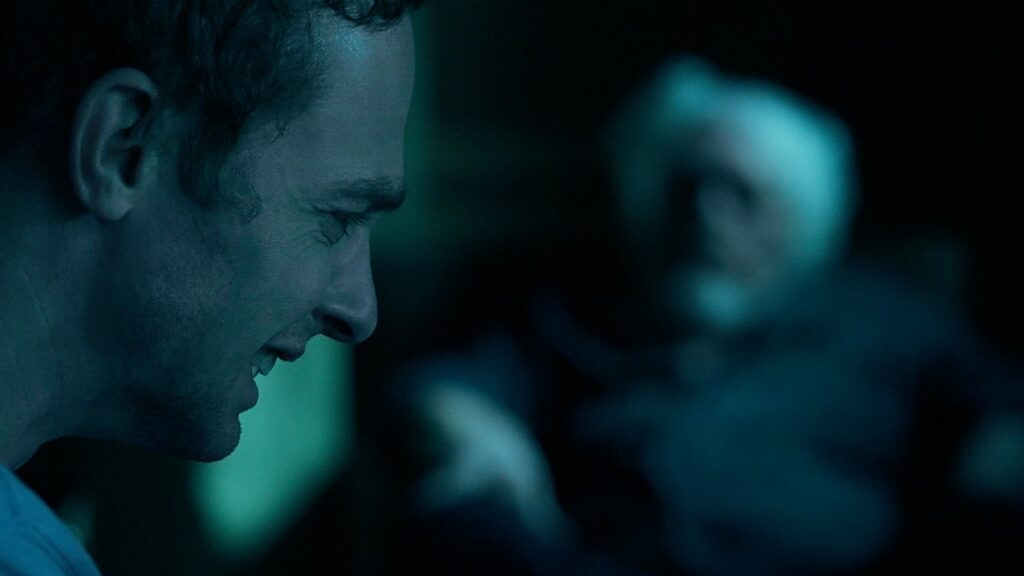
How did you balance the romantic elements of the story with the darker themes of trauma, identity, and the supernatural?
Balancing those elements really came down to structure. I laid everything out on Post-its, each beat I wanted to hit, whether it was emotional, romantic, supernatural, or character-specific, and stuck them on my closet door. I color-coded them: Albert was one color, Devon another, and the ghosts had their own. That let me see the shape of the story in front of me and keep track of how much time we were spending with each thread. If the board started leaning too heavily into horror without giving the relationship space to breathe, I could literally see that imbalance and shift things around. The romantic and horror beats weren’t separate tracks, they had to weave together. I knew this wasn’t a traditional genre piece, so the scares had to come from the same emotional place as the intimacy. The supernatural stuff rises out of the characters’ inner lives, so I didn’t treat it like a twist or external threat. It was all part of the same arc. At the same time, I was subconsciously working through some personal stuff that mirrored the relationship in the film. So while I was being technical, moving beats around and tracking momentum, I was also staying close to the emotional truth of it. That’s probably what helped it feel cohesive. I wasn’t trying to juggle competing tones. I was just trying to tell the story honestly and make sure each element had the space it needed to land.
What was the most challenging aspect of bringing this story to life?
There were plenty of practical challenges: small budget, barely any time, a crew that was working for next to nothing just because they believed in the project. Everyone was wearing multiple hats. We were constantly racing the clock, and there wasn’t a lot of room for second chances. But honestly, the hardest part wasn’t the logistics. It was presenting something that came from a really personal place and the anticipation of having to stand behind it, publicly. This story is tied to my own vulnerability. It’s not autobiographical per se, but it comes from things I’ve lived through, things I’ve wrestled with. And when you’re putting that on screen (especially through the lens of horror, which already asks a lot of your audience) it’s like every step of the process becomes more exposed. Writing it was hard. Directing it was harder. And editing it was maybe the hardest of all, because you’re constantly asking yourself, Is this saying what I need it to say? Or am I just hiding again? At the same time, you’re trying to make something people actually want to watch. It’s a strange tension, wanting to stay honest while also making sure you’re delivering a cinematic experience. Every choice felt like it carried extra weight because it wasn’t just about story or tone, it was about whether I was being understood. And that’s a scary place to create from.
It’s a strange tension, wanting to stay honest while also making sure you’re delivering a cinematic experience.
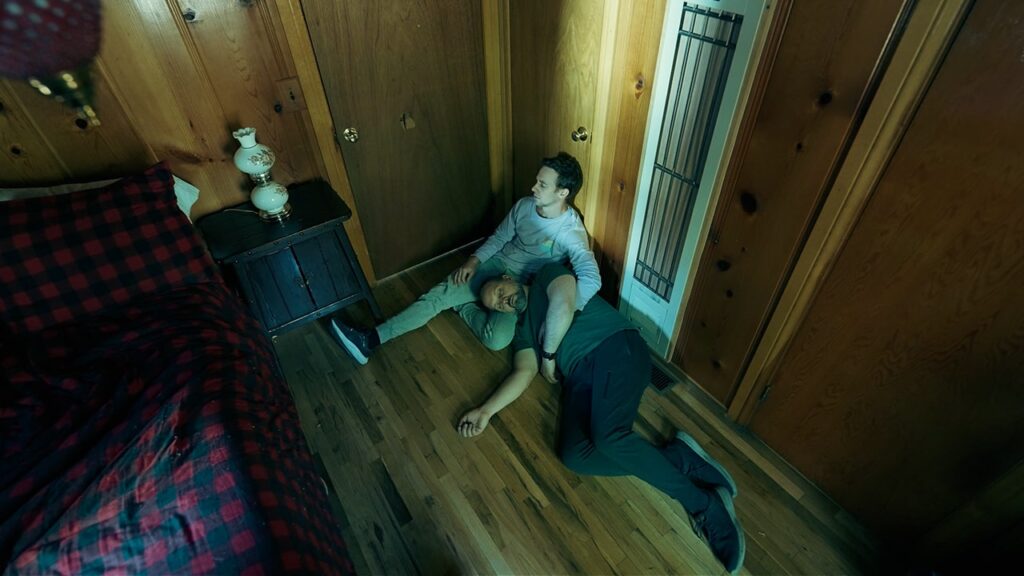
Any fun BTS stories to share?
This was definitely not fun but it was crazy and probably fun to hear about. The day before we were supposed to head up to Big Bear, the Line Fire broke out. The main road up the mountain closed and we were suddenly faced with the very real possibility that the whole production might be canceled before we even got a frame in the can. The morning we were set to leave, we were all glued to our phones, watching fire maps and news updates, trying to figure out if we could safely get there. Eventually we saw that the area where the cabin was located was still clear, and there were two backroads still open. So we took the risk. Halfway up, I got a call that one of my producers’ cars had broken down. The car that had our sound recordist, all of our sound equipment, and most of our food. I reached our cabin, unloaded all of our gear, and turned around to go pick them up. As I descended, I could see the fire on the ridge beside me and, sure enough, as I reached the bottom they closed the road behind me.. So I picked up the producer and tour sound recordist and we drove to the last open road on the back side of the mountain, finally arriving about 5 hours behind schedule. For the next three days, we were getting fire alerts during shooting. Ash was literally falling from the sky. The air was thick, orange, almost surreal. But in a strange way, it completely fit the tone of the film. By day four, Big Bear was basically empty. The whole town felt abandoned, like some post-apocalyptic dreamscape. in the middle of all that, we kept going. The actors locked in, the setting elevated everything, and once the evacuation orders were lifted, it felt like we were exactly where we needed to be. It was stressful but it also gave the film a kind of eerie texture we couldn’t have planned. And weirdly, it made us all more connected to the story we were trying to tell.
Ash was literally falling from the sky. The air was thick, orange, almost surreal. But in a strange way, it completely fit the tone of the film.
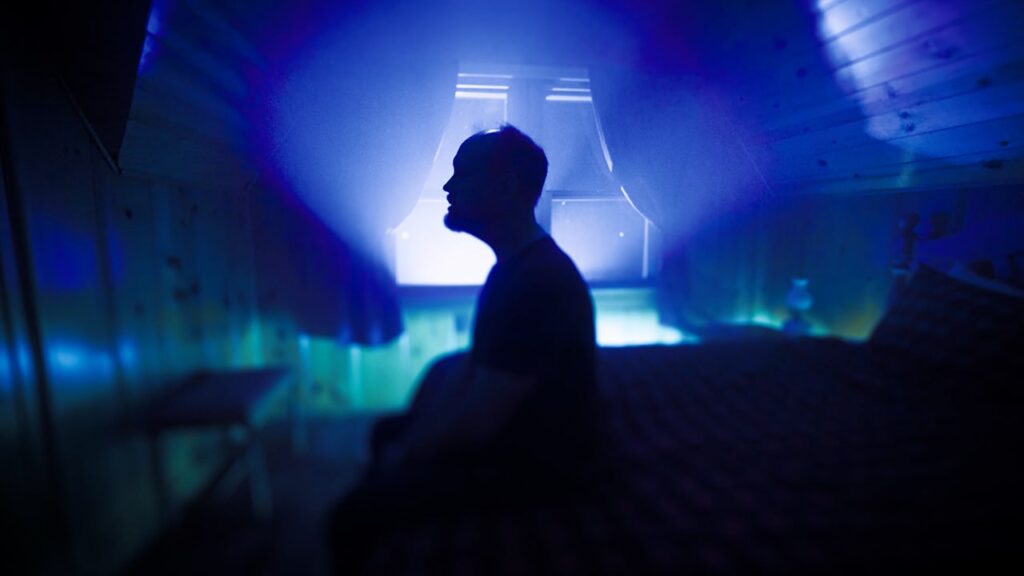
What do you hope horror fans take away from this film?
I hope they leave feeling unsettled, but not in the way you might expect. Shadows of Willow Cabin is less about jump scares and more about the slow dread that creeps in when people are forced to confront what they’ve buried. It’s atmospheric, emotional, and at times surreal. I wanted to make something that feels like a dream you can’t quite wake up from, where the horror comes from memory, regret, silence. So much of what I love about horror is its ability to externalize internal states: to make grief into a ghost, or shame into a trap you can’t escape. I hope horror fans connect with that, and with the tension of two people trying to love each other while everything inside and around them is working against it. And honestly, I just hope it lingers. That’s always my favorite kind of horror. The kind that doesn’t let go right away. The kind that stays with you long after the credits roll.
With Pride Month in full swing, what importance do you place on creating queer horror films, and how do you think they contribute to the genre?
For me, it’s about putting queer characters at the center of the story and not just as metaphors or sidekicks or subtext, but as fully complex people navigating fear, desire, guilt, and love. Horror has always dealt in otherness. It’s a genre built on the idea of the outsider. So in a way, it’s naturally suited to queer storytelling. But for a long time, those stories were buried, coded, or used as the monster. So I think it matters that we’re finally taking up space in the genre. Queer horror doesn’t have to be about trauma only, but when it is, it can speak to something really real. Especially now. The fact that this film is coming out during a time when queer and trans communities are being targeted (again!) makes it feel even more important to say, “We exist. We have stories. And we’re not afraid to make them messy and strange and deeply human.” I think queer horror expands the genre. It adds nuance, depth, contradiction. And it reminds people that fear doesn’t look the same for everyone, but it’s something we all know how to survive.
Learn more about Shadows of Willow Cabin at shadowsofwillowcabin.com. Follow @shadowsofwillowcabin on Instagram and visit the film’s IMDB page.
You might also like
More from Indie Horror
Target Audience – a short dark comedy film
Sponsored Feature: Melvik Productions Target Audience is a new dark comedy short written and directed by Bernardo Hippert and co-written by …
One Night in Body Shop – a new dark fairytale
Sponsored Feature: Rooster Rooster Creative Co. One Night in Body Shop is a dark fairytale written and directed by Alexey Kotolevskiy. …
Outer Reaches – Short. Sweet. Sci-Fi Horror
Sponsored Feature: Forgotten Astronaut Productions + Mad Alice Productions Outer Reaches is a short sci-fi horror film written and directed by …

